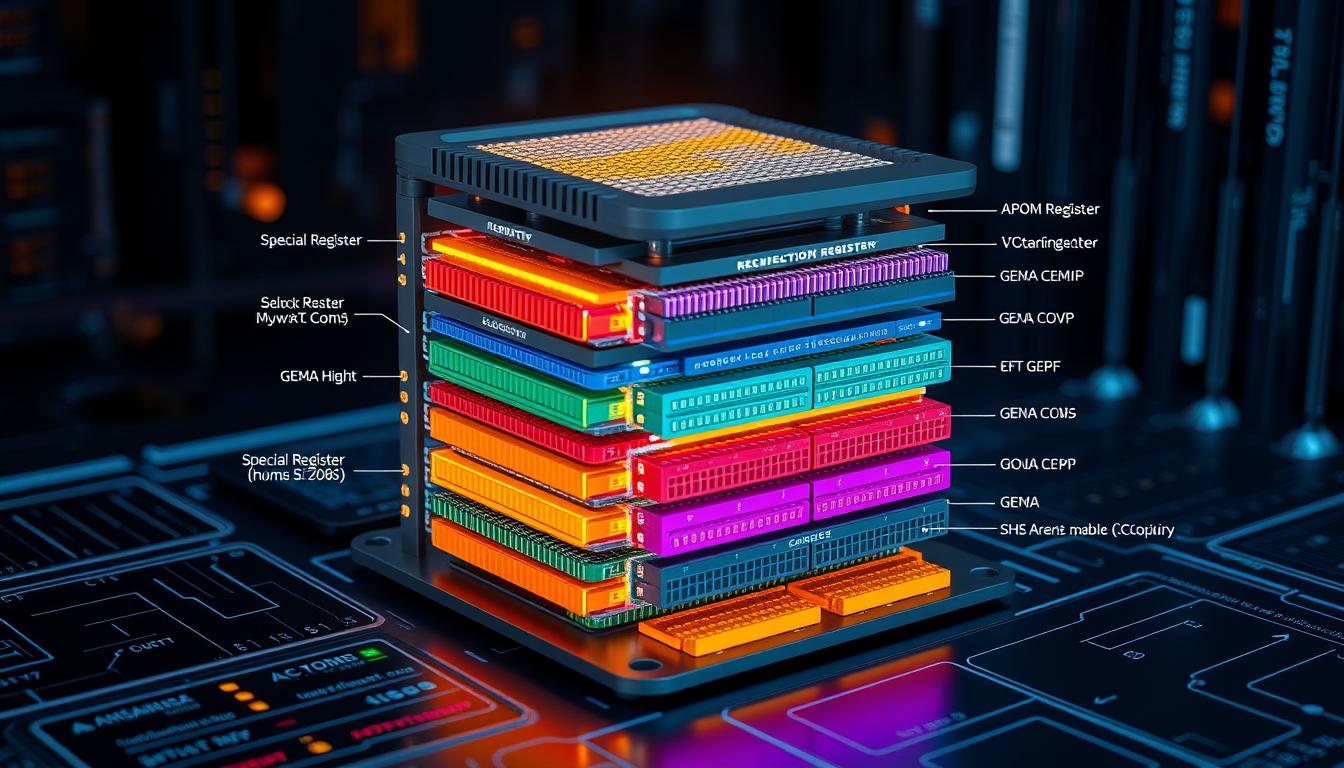Exploring computer system simulation needs deep knowledge of tools like gem5. When adding special registers to ISA in gem5, it’s a complex but interesting process. The gem5 platform is great for setting up special registers in ISA, helping with advanced simulations.
Researchers often need flexible simulators for custom register work. The gem5 simulator is perfect for this, supporting many instruction set architectures. Learning about register setup is key for new hardware designs.
The latest GEM5 version, 24.1.0.1, has better tools for changing architecture. It supports X86, ARM, and RISC-V ISAs. Researchers can use its design to add special registers with ease and flexibility.
Key Takeaways
- gem5 offers a modular way to set up registers.
- It can handle many ISAs in one simulation.
- Knowing system architecture is needed for custom registers.
- gem5’s flexibility is a big plus.
- It’s great for advanced hardware design research.
Understanding GEM5’s Register System Architecture
Gem5 is a complex tool for simulating computer architecture. It has a detailed register system. This system is key for its microarchitectural modeling. It helps researchers and developers add special registers with ease and flexibility.
Gem5 supports many types of registers. These are important for setting up special registers in its ISA. The main types are:
- Integer Registers
- Floating-Point Registers
- Miscellaneous Registers
Register Classification and Types
The register system in gem5 is designed for detailed simulations. Each type of register has its own role. This helps with detailed analysis and exploring microarchitectures.
| Register Type | Primary Function | Typical Use Cases |
|---|---|---|
| Integer Registers | Arithmetic and Logical Operations | Standard computational tasks |
| Floating-Point Registers | Decimal Calculations | Scientific and graphics computations |
| Miscellaneous Registers | Special System Functions | Control and status tracking |
Instruction Representation Mechanisms
Gem5 uses two main classes for instructions: StaticInst and DynInst. StaticInst holds static info about instructions. DynInst tracks dynamic execution details. This setup helps with detailed instruction tracking and analysis.
Thread Context Interface
The ThreadContext interface is key for managing thread states. It gives full access to thread info. This makes it easy to add new registers and set up advanced simulations.
Understanding gem5’s register architecture is key for microarchitectural research and simulation.
How to Add Special Register to ISA in GEM5
To add a special register to the ISA in gem5, you need a good plan. You must understand how the simulator works. This includes knowing about the instruction set architecture of gem5.
When you set up a special register in gem5 ISA, focus on a few important things:
- Find the right ISA description files
- Decide on the new register’s features
- Change how registers are indexed
- Update how instructions are decoded
To add a special register to ISA in gem5, you’ll do several technical things. You’ll work with the StaticInst class. This class holds important info about binary instructions. It lets you set up the new register’s details, like its type and how it works.

- Choose the register type (integer, floating-point, etc.)
- Set up how registers are indexed
- Write functions for how the register works
Precision in register configuration is key to successful ISA extension in gem5.
The gem5 simulator makes it easy to manage registers. This lets developers create detailed register setups. By following these steps, you can add new special registers to the ISA.
Implementing Register Operations and Execution Context
When setting up special registers in gem5 ISA, developers need to know about execution context and register management. They must add special registers to ISA in gem5 carefully. This ensures the simulation runs smoothly.

Creating Execute Functions for Register Operations
Creating execute functions is a big job. It involves several important steps:
- Define precise read and write mechanisms
- Implement instruction-specific interaction protocols
- Establish clear execution pathways
Setting Up Register Access Permissions
Managing special registers needs careful access control. Developers must set up permission levels right. This stops unauthorized changes and keeps the simulation true.
| Permission Level | Access Type | Description |
|---|---|---|
| Read-Only | Restricted Write | Prevents external modification |
| Read-Write | Full Access | Allows complete register manipulation |
| Privileged | Kernel-Level | Restricted to system-level operations |
Handling Register State Changes
Keeping track of register state changes is very important. Good systems make sure complex simulations work well.
“Precision in register state management is the cornerstone of accurate system simulation.”
Conclusion
Adding a special register to ISA in gem5 is a big step forward. It helps researchers and developers make computer architecture simulations better. They can model complex hardware in more detail.
This method lets them explore new design spaces. Spaces that other simulators can’t reach.
Gem5 is very flexible for customizing. Especially when adding special register architectures. It makes performance modeling more precise.
Developers can add custom registers. These capture special microarchitectural details. It’s like PerfVec, but for custom registers.
Testing and checking are key when using gem5. Developers must make sure their custom registers work right. This ensures the simulation is accurate.
By following the right steps, researchers can make powerful simulators. These simulators help us understand processors better.
In the end, adding special registers to ISA in gem5 is a big win. It lets us model complex hardware designs. This gives us deeper insights into how processors work and how to make them better.

